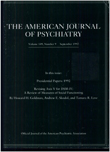Family interactions within incest and nonincest families
Abstract
OBJECTIVE: The study addressed the questions, What are the interactional patterns in families in which incest occurs? and Do these patterns differ from those of families with other clinical problems? METHOD: The families for the study were chosen from two outpatient clinics; the C. Henry Kempe, National Center for the Prevention and Treatment of Child Abuse and Neglect provided access to families with incest, and the nonincest families each had a child seen in a university child psychiatry clinic. In each of these settings, 30 families were selected in the order of referral for evaluation. All families agreed to participate. Each family was given two tasks to perform during a structured interview. The interviews were videotaped, and 15-20-minute segments were rated independently by two of the authors, who used the Beavers-Timberlawn Family Evaluation Scale to assess interactional behaviors within each family. RESULTS: The incest families were significantly more dysfunctional in all but one area of family interaction. The distribution of power within a family did not differentiate the two types of families. CONCLUSIONS: The incest families dysfunctional patterns that seemed to support and maintain the incestuous behavior were a rigid family belief system, a dysfunctional parental coalition, parental neglect and emotional unavailability, and the inability to nurture autonomy in family members.
Access content
To read the fulltext, please use one of the options below to sign in or purchase access.- Personal login
- Institutional Login
- Sign in via OpenAthens
- Register for access
-
Please login/register if you wish to pair your device and check access availability.
Not a subscriber?
PsychiatryOnline subscription options offer access to the DSM-5 library, books, journals, CME, and patient resources. This all-in-one virtual library provides psychiatrists and mental health professionals with key resources for diagnosis, treatment, research, and professional development.
Need more help? PsychiatryOnline Customer Service may be reached by emailing [email protected] or by calling 800-368-5777 (in the U.S.) or 703-907-7322 (outside the U.S.).



